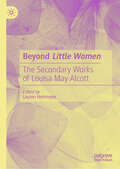Résultats de recherche de titre
Articles 1 à 2 sur 2

A Hopeful Heart: Louisa May Alcott Before Little Women
Par Deborah Noyes. 2020
Braille (abrégé), Braille électronique (abrégé), DAISY Audio (CD), DAISY Audio (Téléchargement Direct), DAISY Audio (Zip), DAISY texte (Téléchargement direct), DAISY texte (Zip), Word (Zip), ePub (Zip)
Etats-Unis (histoire), Philosophie, Sociologie
Audio avec voix de synthèse, Braille automatisé
How did Little Women-- the beloved literary classic and inspiration for Greta Gerwig's acclaimed feature film adaptation--come to be? This…
stunning biography explores the unique family and unusual circumstances of literary icon Louisa May Alcott. Meg, Jo, Beth, and Amy. How did these cherished characters come to be? Louisa May Alcott, the author of one of the most famous "girl" books of all time, was anything but a well-mannered young lady. A tomboy as well as a ravenous reader, Louisa took comfort in fictional characters that were as passionate and willful as she was--and whose wild imaginations were a match for her own. She was often found roaming the woods near her home in Concord, Massachusetts, or exploring the natural world in the company of the great Transcendentalist thinkers Ralph Waldo Emerson and Henry David Thoreau. Here is a beautiful portrait of Louisa May Alcott, a woman influenced by her father, a penniless philosopher, her mother, with whom she shared a great connection, and, of course, her three sisters. Featuring unique indigo illustrations, Deborah Noyes unveils how Louisa's natural spirit, loving family, and unconventional circumstances inspired the timeless masterpiece that is Little Women.
Beyond Little Women: The Secondary Works of Louisa May Alcott
Par Lauren Hehmeyer. 2025
Braille (abrégé), Braille électronique (abrégé), DAISY Audio (CD), DAISY Audio (Téléchargement Direct), DAISY Audio (Zip), DAISY texte (Téléchargement direct), DAISY texte (Zip), Word (Zip), ePub (Zip)
Etats-Unis (histoire), Critiques
Audio avec voix de synthèse, Braille automatisé
This collection concentrates on the secondary works of Louisa May Alcott and looks at the idea that Alcott was as…
heavily influenced by her times as by her transcendentalist upbringing. Her work often subverts the conventional and includes the new, the practical, and the real. The sections include: (1) the gothic and the monstrous feminine, (2) the theme of useful work, (3) the themes of physical and mental health, and (4) Alcott’s philosophy concerning creativity and genius. Contributors emphasize Alcott’s belief in women’s agency and argue that Alcott can be considered as a brilliant bridge between the Transcendental idealism of the early nineteenth century and later reforms.